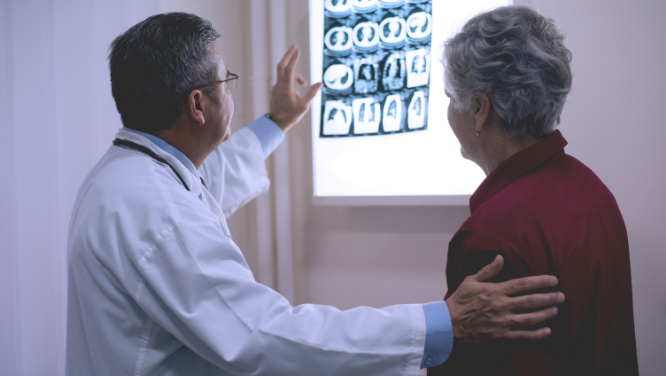Friday, 03 November 2023
What is Infertility? 10 Steps to IVF Treatment

Let's say hello to your miracles together with our expert team and advanced health technologies.
At the Anadolu Medical Center IVF Center, a treatment aimed at the cause is first proposed to couples applying with the desire to have children. If infertility is present, general reproductive assistance treatments may be applied.
The fertilization of a human egg outside the body was first successfully achieved in 1973, but no pregnancy resulted from the resulting embryo. In July 1978, the first test-tube baby, "Louise Brown," was born in England. After this, hormone drugs used in ovulation treatments began to be developed. The real progress was recorded in 1996 with the discovery of ICSI (intracytoplasmic sperm injection). Thus, the success rate in IVF applications increased, and significant progress was made in male infertility problems.
Throughout normal life, an adult woman produces one egg cell each month until menopause. In many infertility (sterility) treatments, the number of egg cells is increased to produce more embryos. This process is done through the short-term use of various hormone drugs. Having more eggs will increase the chance of fertilization and developing quality embryos, allowing the best quality embryo to be placed in the mother.
Unlike the single egg cell produced each month, the male reproductive cells, sperm, are numerous, numbering in the millions. The process of creating a sperm cell in the male reproductive organs takes approximately 75 days. At the end of this period, the mature sperms are expelled into the external environment within the semen. Under normal conditions, sperm cells race towards a single egg, and the fastest and highest quality one breaks through the outer membrane of the egg cell to achieve fertilization.
After the sperm enters the egg cell, two "pronuclei," which are indicative of fertilization, become visible 16-20 hours later. One of the pronuclei contains the genetic material, or chromosomes, from the mother, and the other contains the genetic material from the father. As time progresses, these two pronuclei merge and combine to form the chromosomes of the offspring.
Infertility, also known as sterility, is a common and significant issue in today's society. Approximately 10-15% of couples of childbearing age face difficulties in conceiving and can only have children with medical treatment.
Infertility can originate from either the woman, the man, or both. In 40% of infertility cases, the issue is related to low sperm count or quality in men, while in another 40%, the cause is related to factors from the woman. Infertility is attributed to both partners in about 10% of cases, and in the remaining 10%, no specific cause for infertility can be identified despite normal test results. This condition is referred to as "unexplained infertility."
One in every 7-10 couples experiences infertility problems. In the United States alone, approximately 10 million couples face infertility issues, while in Turkey, around 2-3 million couples are affected.
Worldwide, there are over 8 million babies born through IVF to date.

Female-related infertility refers to the decreased or loss of ability to conceive due to factors originating from a woman's reproductive system. Examples of causes include irregular ovarian functions, tubal blockages, and endometriosis.

Male infertility refers to the condition where factors originating from the male reproductive system reduce or eliminate the ability of the sperm cell to join with the egg and achieve pregnancy. Examples of causes of male infertility include insufficient sperm production, reduced sperm motility, or abnormalities in sperm morphology.
The following methods may be applied to couples seeking treatment at the IVF center to have children:
Embryo Scratching
The embryo's attachment to the mother's uterus occurs by breaking through the membrane surrounding it, exiting, and attaching to the uterine wall. In cases where this surrounding membrane is thick, or the mother's age is advanced, the attachment becomes difficult, or may not occur at all. Embryo scratching involves thinning this membrane under a microscope.
Blastocyst Transfer
This method is applied if at least 5 high-quality embryos are obtained in the first three days after fertilization. Performed on the fifth day after egg retrieval, this transfer is useful for selecting the best embryos. It is also suitable for minimizing the possibility of multiple pregnancies.
Embryo Freezing
The best-quality embryos are transferred to the mother. Remaining good-quality embryos can be frozen and stored for future use. If pregnancy is not achieved after the first transfer or if a second child is desired, the embryos can be thawed and transferred to the uterus again.
This process eliminates the need for ovarian stimulation with medications and egg retrieval. The embryos are subjected to various solutions at specific time intervals and temperatures to help them gain resistance to freezing. They are then placed in an embryo freezing device. As per regulations, embryos can be stored with annual consent.
Preimplantation Genetic Testing (PGT or PGD)
The chromosomal structure of the unborn baby, meaning the genetic material in the cells, is examined through screening tests during pregnancy (such as the double and triple tests) and by analyzing cells from the pregnancy sac (amniocentesis).
Preimplantation genetic testing, i.e., genetic testing done before embryo transfer to the mother, is a very important diagnostic method for couples at risk of having a child with genetic disorders or a carrier of genetic diseases. PGT is recommended for couples with recurrent pregnancy losses, advanced maternal age, or multiple failed IVF attempts. This method allows couples to have a healthy child by excluding genetic diseases.
How is Preimplantation Genetic Testing (PGT or PGD) applied?
After evaluating whether the patient is suitable for PGT, a genetic test is performed on the blood taken from the patient or carrier individuals. For this, the female patient is prepared for IVF treatment. The retrieved eggs are fertilized with the male partner's sperm. On the 5th day of embryonic development (Blastocyst), 3-5 cells (blastomeres) are taken under a microscope. After the biopsy, these cells are sent to the genetic diagnosis laboratory. After various procedures, it is determined which embryos carry the disease and which do not. Embryos that do not carry the disease are transferred to the mother's uterus.
In light of scientific data, the application of PGT to all embryos has not been accepted. The generally accepted practice in the international medical community is to apply PGT when there is a known family history of genetic anomalies, a chromosomal disorder detected in previous pregnancies, repeated miscarriages, or when the mother is of advanced age, increasing the risk of chromosomal disorders.
Embryoglue
Embryoglue, also known as embryo glue, is an embryo culture medium enriched with hyaluronan, which is applied before the embryo transfer. Hyaluronan enhances the interaction between the embryo and the uterine wall, helping the embryo attach to the uterus. Therefore, this method is used to increase the success rate in IVF treatments.
Microchip
Sperm chips, used for selecting healthy sperm, consist of microchannels. First, a special solution is placed in these channels, followed by sperm. Just like the natural passage of sperm through the tubes in the body, sperm pass through these channels, while sperm with damaged DNA get stuck, and healthy sperm pass through to be collected on the other side. This method can be particularly useful for individuals with severe structural problems in their sperm, as it helps achieve better-quality embryos through microinjection.
PRP (Platelet-Rich Plasma)
PRP is a method recently used in many areas of medicine. Its effect is based on separating the individual's own blood cells (platelet-rich plasma) and injecting them into the area of the body that needs them, activating inactive cells in that region.
PRP can be applied in IVF treatment for two reasons:
Glutathione Treatment
Glutathione is a naturally occurring antioxidant in our body that protects our cells from the harmful effects of free radicals. Glutathione slows down aging and reduces inflammation.
Glutathione is essential for the normal functioning of many organs, including the reproductive organs, liver, brain, and intestines.
Glutathione treatment can be used as a supportive treatment in IVF to increase antioxidant effects, aiming to obtain better oocytes and better sperm. This treatment is particularly suitable for men with severe sperm problems and women with poor egg quality.
Oocyte Activation
Oocyte activation is a method applied, particularly in cases of fertilization failure or insufficient fertilization. The goal is to increase the chances of the egg being fertilized by sperm.
Oocyte activation is performed through electrical, chemical, or mechanical methods. The most commonly used method today is the chemical method, which involves incubating the eggs in a calcium ionophore solution after microinjection.
Oocyte activation with calcium ionophore can successfully solve fertilization problems, especially in cases where the problem is sperm, egg-related, or unexplained.
IMSI
In routine microinjection procedures, sperm selection is performed under 200x magnification, whereas the IMSI method allows up to 6000x magnification. This improves sperm selection, particularly in men with severe sperm issues, increasing the chance of creating a healthy embryo.
On the 2nd or 3rd day of the patient's menstrual cycle, an ultrasound is performed. If there are no obstacles in the uterus or ovaries to start treatment, hormonal medications in the form of pills or injections are given to stimulate the ovaries. During this period, ultrasound monitoring is performed at regular intervals. When the egg reaches the desired size, timed intercourse is recommended.
This method is used in cases of mild sperm issues related to count, motility, or morphology, the presence of cervical mucus problems (sperm-killing antibodies), inability to have intercourse, and unexplained infertility. In this method, the woman's eggs are stimulated with hormones, and the timing of the procedure is determined based on the development of the eggs. The sperm sample collected from the male is processed in a special laboratory to increase its quality and motility. Healthy, fast-moving sperm are separated for use in the procedure. The prepared sperm is placed in the woman's uterus using a special catheter while she is in an examination position, and after the procedure, the patient rests for half an hour. The success rate of this procedure may vary from person to person.
In this method, the eggs stimulated by hormones are monitored through ultrasound at regular intervals. When the follicle (egg sacs) reach a certain size, preparations for egg retrieval are made. This process takes about 8-10 days. After the last injection (Trigger Shot) that plays a role in egg maturation, egg retrieval occurs 34-36 hours later. The collected eggs are placed in special solutions in laboratory conditions. They are kept in incubators with a suitable gas mixture for embryos at 37°C body temperature. These incubators, which are humid and dark, mimic the mother's uterus. On the other hand, sperm collected from the patient's partner undergoes special procedures in the lab to prepare it.
After preparation, in the classic IVF method, eggs and sperm are combined under a microscope, and fertilization is expected. Each egg should have 50,000-100,000 sperm around it. The fertilization of the eggs is checked the following day, and their division is monitored over the next few days, with all data recorded in the patient's file.
At the appropriate time (the second, third, fourth, or fifth day following the procedure), the best-quality embryos are selected by the embryologist and gynecologist. A suitable number of embryos are transferred into the uterus using a thin catheter. The number of embryos transferred depends on the mother's age, embryo quality, and previous attempts. In normal procedures, this number is limited to a maximum of two embryos.
This method is applied when the sperm count, motility, or normal structure is low in the semen sample, or when normal sperm fail to fertilize the egg. The maturity of the eggs that will undergo microinjection should be determined beforehand. Sperm with proper structural features are selected under high magnification through a microscope and injected into the egg. This procedure ensures the fertilization of a single egg with a single sperm cell. Afterward, as in IVF, fertilization is checked the next day, and cell division is monitored in the following days. The highest-quality suitable embryos are transferred into the mother's uterus.
After the sperm enters the egg cell, two "pronuclei" appear after 16-20 hours, which is the sign of fertilization. One of the pronuclei contains the genetic material (chromosomes) from the mother, and the other contains the genetic material from the father. As time passes, these two pronuclei merge into each other, forming the chromosomes of the embryo.
Two-cell, four-cell, eight-cell
The embryo formed undergoes its first division approximately 26 hours later, forming two cells. The next day, it forms four cells, and on the third day, it becomes a 6-8 cell embryo.
Five-day embryo
In a four-day embryo, the cell count is not visibly distinguishable, and it takes on a compact appearance. In a five-day embryo, a fluid-filled cavity forms, and it contains approximately 150-200 cells, becoming a blastocyst.
The transferred embryo attaches to the mother's uterus by tearing its surrounding membrane, exiting, and adhering to the uterine wall.
The absence of sperm in the semen is known as azoospermia. It occurs due to blockages in the sperm-carrying ducts or disorders in sperm production in the testes. The treatment method is microinjection. In this treatment, sperm retrieval is performed through surgical procedures known as TESA or TESE, carried out by a urologist. Currently, about 5% of couples visiting IVF centers are treated with these methods.
TESA (Testicular Sperm Aspiration)
This method is used when there is no sperm found in the semen due to blocked or undeveloped sperm-carrying ducts, or very limited sperm production. It involves withdrawing fluid from the testes using a needle to obtain sperm cells.
The procedure is performed under local anesthesia, and the patient can resume normal activities on the same day. The mature or developing sperm obtained by this method are used in ICSI (microinjection) procedures.
TESE (Testicular Sperm Extraction)
When TESA does not yield results or in cases of advanced sperm production deficiency, a sample is surgically taken from the testes. The operation is performed under local anesthesia, and the patient can return to their normal life the same day. This procedure involves taking small tissue fragments from the testes. The obtained tissue samples are further examined under a microscope. If sperm cells are found, they undergo various preparatory stages to be used in ICSI (microinjection).
Micro TESE Method
Men with azoospermia who are unable to have children can have children through a method called 'microscopic testicular sperm extraction' or 'micro TESE.' In cases where there is no obstruction, sperm production in the testes is either absent or very limited in specific areas. While some tubules may have no production, others may contain a small number of sperm. In men without sperm in their semen, this procedure uses an operating microscope to identify areas with sperm more easily, enabling sperm retrieval. Under anesthesia, the testes are opened and examined under a microscope. This method allows for better identification of areas where sperm is produced, and because less tissue is removed, samples can be taken from multiple areas. The use of the operating microscope makes it easier to distinguish areas with a higher likelihood of sperm presence. It also minimizes damage to the blood vessels supplying the tissue.
This method increases the chances of finding sperm and ensures that more sperm can be obtained. Another important factor is that the tissue loss from the testes is significantly lower compared to the older method.
This way, the operation minimizes damage to the testes, and processes that could reduce the levels of testosterone in the blood are avoided.
Infertility is when couples are unable to conceive despite having unprotected sexual intercourse for one year. IVF treatment is commonly applied in the following situations:
There is no difference between pregnancies achieved through IVF and those that occur naturally.
If a married couple has been trying to conceive for 1 year without success, it is recommended to seek expert help and begin appropriate treatment. However, for those aged 35 and older, we advise shortening this period to 6 months.
If hormone tests and ultrasound indicate that ovarian capacity and function are appropriate, IVF treatment can be applied up to the age of 46-47.
There is no limit to the number of IVF attempts, as the safety of the hormonal medications used in IVF has been demonstrated by numerous scientific studies. However, it is a well-known fact that the success rate decreases after the third IVF attempt.
If the sperm count is low, fertilization of the egg is achieved using the ICSI (Intracytoplasmic Sperm Injection) method.
If no sperm is found in the semen, a surgical procedure to retrieve sperm from the testis is performed (TESA or Micro-TESE procedure).
* Before undergoing treatments such as chemotherapy and radiotherapy (for women who need to start treatments that damage egg cells, like chemotherapy and radiotherapy)
Operations related to reproductive functions (for patients undergoing surgeries that may lead to loss of reproductive function, such as removal of ovaries)
In cases of a family history of early menopause (for women with a family history of early menopause or those with low ovarian reserve but who are not yet considering pregnancy)
If planning to become a mother at an older age
For women who focus on their careers and delay motherhood until their late 30s
For single women who have been diagnosed with low ovarian reserve and do not plan to marry in the near future, egg freezing is recommended.
At the Anadolu Medical Center's IVF Department, we currently freeze eggs using the latest vitrification technique at -196 degrees Celsius in liquid nitrogen. According to scientific data and our own observations, the duration of storage, whether long or short, does not affect the quality or genetic profile of the eggs.
Success rates for IVF treatment have risen to 65-70% over the last 20 years. One of the main reasons for this increase is the advancement in laboratory environments. Modern embryology laboratories can better analyze the nutrients and conditions needed for embryos and perform genetic analyses to select healthier embryos. Additionally, the success rate of embryos that are frozen and thawed has now exceeded the success rate of fresh embryos in some cases, whereas it was previously half as effective. Furthermore, the introduction of new medications, improved treatment methods, reduced errors, and increased experience of doctors have all contributed to higher success rates in IVF treatment.
In our laboratory, embryos frozen using the vitrification technique can achieve the same pregnancy rates as fresh embryo transfers. In some cases, the success rate of frozen embryo transfer can be higher due to better control of the uterine development. It is encouraging to note that the survival rate of embryos after thawing is around 97%.
Nowadays, increasing environmental pollution, stress, nuclear waste, genetic modifications in food, and hormones used as additives negatively affect sperm production and ovarian reserve. Additionally, aging significantly reduces ovarian reserve and can affect sperm count.
It is generally accepted that fertility decreases with age. While women in their 20s and 30s have a 25-30% chance of conceiving in a single menstrual cycle, this rate drops to 5% at the beginning of their 40s. Age is the most significant factor affecting the success rates of fertility treatments. The quality of eggs deteriorates with age, ovarian reserve significantly decreases, and the risk of abnormalities in eggs increases, all of which contribute to the reduced pregnancy rates.
PGD is recommended for couples who have a hereditary disease and wish to have a healthy child. It is also advised for couples undergoing assisted reproductive techniques like IVF or ICSI, where there is a high risk of chromosomal abnormalities in embryos (e.g., advanced maternal age, repeated pregnancy losses, severe sperm problems, repeated IVF failures).
In-vitro Fertilization (IVF) Department
Prof. Tayfun Kutlu
In-vitro Fertilization (IVF) Department
MD. Surgeon Ebru Öztürk Öksüz
In-vitro Fertilization (IVF) Department
Embryologist Dr. Gözde Kaya
Urology Department
Prof. Cüneyt Adayener
Videos
All videosTüp bebek tedavisinde yanlış bilinenler - Prof. Dr. Tayfun Kutlu - Dr. Ebru Ö. Öksüz - Oksijen TV
Tüp bebek tedavisinde yanlış bilinenler - Prof. Dr. Tayfun Kutlu - Dr. Ebru Ö. Öksüz - Oksijen TV
Anne Olmayı Engelleyen Sağlık Sorunları - Doç. Dr. Tayfun Kutlu - FOX TV
Tüp Bebek Tedavisi Hakkında Merak Edilenler?
Tüp Bebek Tedavisi Hakkında Merak Edilen Her Şey - Canlı Yayın
Tüp Bebek Tedavisi Nasıl Yapılır? Tüp Bebek Tedavi Aşamaları Nelerdir?
Tüp Bebek Tedavisiyle İlgili Merak Edilen Her Şey - Canlı Yayın
Tüp Bebek Tedavisi Süreci Nasıl Başlar?
Üremeye Yardımcı Bir Tedavi Tekniği olan Aşılama Nedir?
Tüp Bebek Tedavisi Hangi Sıklıkla Yapılır?
Tüp Bebek Tedavisinde Genetik Tanı Testi Kimlere Önerilir?

We listen to your opinions and suggestions to further enhance our service quality.

You can fill out the form to get a second doctor's opinion on the results of your tests, the diagnosis of your illness, and the treatment options we offer you.

You can receive the healthcare services you need at your home. Please fill out the form for home healthcare services.
Featured Articles
Processing of Personal Data: I consent and approve the processing of my personal data and contact information, which I provided during the registration process, by Private Anadolu Medical Center Hospital and Private Anadolu Health Ataşehir Medical Center, both in relation to my examination, appointment, and treatment, and for all kinds of health-related information, promotions, openings, invitations, event reminders, and communication activities.
Commercial Electronic Message: I agree to receive Commercial Electronic Messages from Private Anadolu Medical Center Hospital and Private Anadolu Health Ataşehir Medical Center for all kinds of health-related information, promotions, openings, invitations, event reminders, and communication activities.